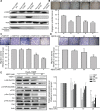Liver fatty acid-binding protein (L-FABP) promotes cellular angiogenesis and migration in hepatocellular carcinoma
- PMID: 26919097
- PMCID: PMC4951284
- DOI: 10.18632/oncotarget.7571
Liver fatty acid-binding protein (L-FABP) promotes cellular angiogenesis and migration in hepatocellular carcinoma
Abstract
Liver fatty acid-binding protein (L-FABP) is abundant in hepatocytes and known to be involved in lipid metabolism. Overexpression of L-FABP has been reported in various cancers; however, its role in hepatocellular carcinoma (HCC) remains unclear. In this study, we investigated L-FABP and its association with vascular endothelial growth factors (VEGFs) in 90 HCC patients. We found that L-FABP was highly expressed in their HCC tissues, and that this expression was positively correlated with that of VEGF-A. Additionally, L-FABP significantly promoted tumor growth and metastasis in a xenograft mouse model. We also assessed the mechanisms of L-FABP activity in tumorigenesis; L-FABP was found to associate with VEGFR2 on membrane rafts and subsequently activate the Akt/mTOR/P70S6K/4EBP1 and Src/FAK/cdc42 pathways, which resulted in up-regulation of VEGF-A accompanied by an increase in both angiogenic potential and migration activity. Our results thus suggest that L-FABP could be a potential target for HCC chemotherapy.
Keywords: angiogenesis; hepatocellular carcinoma; liver fatty acid-binding protein; vascular endothelial growth factor.
Conflict of interest statement
No conflict of interest exists in the submission of this manuscript, and the manuscript was approved by all authors for publication.
Figures







Similar articles
-
[Expression of liver-type fatty acid-binding protein and vascular endothelial growth factor and their correlation in human hepatocellular carcinoma].Nan Fang Yi Ke Da Xue Xue Bao. 2007 Mar;27(3):318-21. Nan Fang Yi Ke Da Xue Xue Bao. 2007. PMID: 17425983 Chinese.
-
Fatty acid binding protein 5 promotes tumor angiogenesis and activates the IL6/STAT3/VEGFA pathway in hepatocellular carcinoma.Biomed Pharmacother. 2018 Oct;106:68-76. doi: 10.1016/j.biopha.2018.06.040. Epub 2018 Jun 26. Biomed Pharmacother. 2018. PMID: 29957468
-
HS-116, a novel phosphatidylinositol 3-kinase inhibitor induces apoptosis and suppresses angiogenesis of hepatocellular carcinoma through inhibition of the PI3K/AKT/mTOR pathway.Cancer Lett. 2012 Mar 28;316(2):187-95. doi: 10.1016/j.canlet.2011.10.037. Epub 2011 Nov 4. Cancer Lett. 2012. PMID: 22182943
-
The Role of Elevated Liver-Type Fatty Acid-Binding Proteins in Liver Diseases.Pharm Res. 2021 Jan;38(1):89-95. doi: 10.1007/s11095-021-02998-x. Epub 2021 Feb 3. Pharm Res. 2021. PMID: 33534129 Review.
-
The mechanisms of angiogenesis in hepatocellular carcinoma: angiogenic switch during tumor progression.Surgery. 2002 Jan;131(1 Suppl):S135-41. doi: 10.1067/msy.2002.119365. Surgery. 2002. PMID: 11821800 Review.
Cited by
-
The Multifunctional Family of Mammalian Fatty Acid-Binding Proteins.Annu Rev Nutr. 2023 Aug 21;43:25-54. doi: 10.1146/annurev-nutr-062220-112240. Epub 2023 May 19. Annu Rev Nutr. 2023. PMID: 37207357 Free PMC article. Review.
-
The role of mitochondria-related genes in hepatocellular carcinoma prognosis: construction of prognostic models based on machine learning.Discov Oncol. 2025 Jul 25;16(1):1407. doi: 10.1007/s12672-025-03216-5. Discov Oncol. 2025. PMID: 40715829 Free PMC article.
-
The implications of signaling lipids in cancer metastasis.Exp Mol Med. 2018 Sep 21;50(9):1-10. doi: 10.1038/s12276-018-0150-x. Exp Mol Med. 2018. PMID: 30242145 Free PMC article. Review.
-
Deletion of PGAM5 Downregulates FABP1 and Attenuates Long-Chain Fatty Acid Uptake in Hepatocellular Carcinoma.Cancers (Basel). 2023 Sep 29;15(19):4796. doi: 10.3390/cancers15194796. Cancers (Basel). 2023. PMID: 37835490 Free PMC article.
-
Update on blood-based biomarkers for chronic liver diseases prognosis: Literature review and institutional experience.JGH Open. 2021 Oct 30;5(11):1250-1256. doi: 10.1002/jgh3.12667. eCollection 2021 Nov. JGH Open. 2021. PMID: 34816010 Free PMC article. Review.
References
-
- Kaseb AO, Hanbali A, Cotant M, Hassan MM, Wollner I, Philip PA. Vascular endothelial growth factor in the management of hepatocellular carcinoma: a review of literature. Cancer. 2009;115:4895–4906. - PubMed
-
- Romanque P, Piguet AC, Dufour JF. Targeting vessels to treat hepatocellular carcinoma. Clin Sci (Lond) 2008;114:467–477. - PubMed
Publication types
MeSH terms
Substances
LinkOut - more resources
Full Text Sources
Other Literature Sources
Medical
Molecular Biology Databases
Miscellaneous

